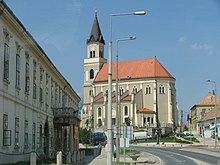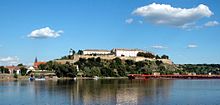Franz von Ottinger

Franz Freiherr von Ottinger (born September 28, 1793 in Ödenburg ; † April 8, 1869 in Vienna ) was an Austrian Real Privy Councilor , officer ( general of the cavalry ) and Knight of Theresa as well as the second owner of the Hussar Regiment "Kaiser" No. 1 .
biography
Ottinger joined ex propriis in 1810 as a cadet in Hussar Regiment No. 5, was promoted to officer in Hussar Regiment No. 8 in 1813 and again served as First Lieutenant in Hussar Regiment No. 5. In the latter capacity, he fought on February 17, 1814 in the Parma region near Cadeo with great skill until the moment of his wounding, so that part of the kk infantry, which had already been cut off, could escape imminent captivity. His behavior in the battle at Fiorenzuola on April 13th of the year in which he swam through the raging taro with his hussars and immediately afterwards when driving the French back to Castelguelfo , despite being severely wounded, was just as persistent that he was so much involved in the king of Naples Joachim Murat was awarded the Order of the Two Sicilies.
After several months of sick leave, he returned to active service, where on May 4, 1815 he was given the task of observing the enemy retreating from Macerata to Fermo with hussar and dragoons. On this occasion he held on to the enemy cavalry debouching from a ravine until the main column had advanced, which led to the enemy being completely dispersed.
In the campaign against Ravenna in 1821 Ottinger was sent to the imperial consul in Ancona with verbal and written orders and then to reconnoiter the Tronto . The officer was honored with public recognition for this meritorious cavalcade at the head of 20 riders in just ten days via Senigallia , Loreto (Marken) , Fermo, the Tronto and back to Foligno .
Until 1848 he was successful in training the troops. Due to his exemplary military behavior, he quickly advanced in the hierarchy: in 1825 Rittmeister 2nd class, in 1830 Rittmeister 1st class, on April 25, 1834 major , on August 5, 1836 lieutenant colonel , always with the Hussar Regiment King of Sardinia No. 5 , finally on December 7, 1838 Colonel and Commander of Hussar Regiment No. 1.

On July 10, 1846, he was promoted to major general . At the beginning of operations in Hungary in 1848 , the general commanded the cavalry brigade in the Army Corps of Field Marshal Lieutenant Jellacic . Field Marshal Prince Alfred Windisch-Graetz ordered him to pursue the enemy arms on a forced march to Bábolna . His victory in the battle there over the enemy avant-garde on December 28th of that year meant the rescue of the Bábolna stud , but also the complete defeat of the Hungarian units consisting of infantry and cavalry and their rejection as far as Szent-Igmand . In addition, 7 officers and 700 men were taken prisoner. Only two days later he won again at Moor . There, knowing the favorable conditions, without waiting for Hartlieb's division, he attacked the enemy on his own responsibility and captured a Honvéd battalion while advancing on the enemy line of retreat. For this he was decorated with the Knight's Cross of the Military Order of Maria Theresa (153rd doctorate on July 29, 1849).
Immediately after taking Pest-Ofen , Ottinger was sent with his cuirassier brigade at the beginning of January 1849 to occupy Szolnok . He had the railroad and telegraph connection to Pest restored quickly and seized significant supplies of grain, salt and a Kossuth note press in Szolnok. By skillfully intervening in combat, Ottinger demonstrated his ability to the enemy, better equipped with artillery, at Szolnok on January 22nd, Cegléd on January 25th, Czibakháza on February 4th and 24th, and again Szolnok on March 5th, where he was able to save the Karger Brigade from total defeat , only to strike at Isaszeg on April 6th.
After the general inflicted heavy losses on the enemy five days later on the Rákosbach and led them to flee, he was promoted to field marshal lieutenant and cavalry division in the southern army on April 30, 1849 . In this function he proved himself again especially in the one near Káty (Kács) north of Peterwardein , on June 9th, where he led the enemy to rash advance, only to attack them violently on both flanks and to make them flee uncontrollably, however also in the battle of Hegyes on July 14th, during which a horse was shot in the body. He then worked as a division commander in Hungary until 1856.
In recognition of his achievements, Emperor Franz Joseph I granted him the title of baron in Vienna on February 22, 1851, which was transferred to his nephews and adoptive sons Gottfried and Gustav Adolf on October 18, 1858 and September 16, 1865 with imperial approval. In 1852 he became the 2nd owner of the hussar regiment "Kaiser" No. 1. On November 15, 1856, the baron received renewed evidence of the benevolence of his warlord by being appointed first lieutenant of the 1st Arcièren Life Guard and with the Commander's Cross of the Austrian Imperial Leopold Order was awarded. Honored on April 7, 1860 with the title of a Privy Councilor, Ottinger was allowed to retire as General of the Cavalry ad honores on January 1, 1867 .
The general has a grave of honor in Vienna's central cemetery .
Awards (selection)
- Knight's Cross of the Military Maria Theresa Order
- Commander of the Austrian-Imperial Leopold Order
- Order of the Iron Crown 2nd class
- K. k. Military Merit Cross
- Royal Order of the Two Sicilies
coat of arms
1851: Squared shield. 1 and 4 have a silver field. 2 in red an armored arm protruding from the left side edge, the fist of which bears a shiny ancient saber on golden buttocks, which hits the cranium of a forward-facing, rumped Moor's head on the right side edge. 3 in red on a hill rising from the edge of the foot, a tinned tower built from ashlar pieces with a locked gate, in which the portcullis is lowered halfway, and two arched windows placed side by side above the gate. On the shield rests the baron's crown, on which rises a crowned helmet placed in its sights, from the crown of which two open eagle wings, turned against each other with the Saxons and alternately divided transversely by silver and red, protrude. The helmet covers are covered with silver on both sides in red.
Others
Johann Strauss (son) dedicated the Ottinger-Reiter-Marsch , op.83 (1850) to Ottinger .
literature
- History of the Imperial and Royal 5th Hussar Regiment in Schels' "Austrian military magazine", Volume 2, Vienna 1834.
- Joseph Strack: "The Generals of the Imperial and Royal Army", Keck Verlag, Vienna 1850.
- Jaromir Hirtenfeld : “The Military Maria Theresa Order and its Members”, Verlag der Buchhandlung für Militärliteratur Karl Prohaska, Vienna 1857, p. 1620 ff.
- Constantin von Wurzbach : Ottinger, Franz Freiherr von . In: Biographisches Lexikon des Kaiserthums Oesterreich . 21st part. Kaiserlich-Königliche Hof- und Staatsdruckerei, Vienna 1870, pp. 132–134 ( digitized version ).
- Adolf Schinzl : Ottinger, Franz . In: Allgemeine Deutsche Biographie (ADB). Volume 24, Duncker & Humblot, Leipzig 1887, p. 565 f.
Individual evidence
- ↑ a b Nekrolog in the "Militär-Zeitung" from Wednesday, April 28, 1869, p. 293
- ↑ a b http://www.deutsche-biographie.de/sfz74077.html
- ↑ Vereinigte Ofner-Pester Zeitung No. 87, Wednesday, October 30, 1834, p. 1639
- ↑ Vereinigte Ofner-Pester Zeitung No. 5, Thursday, January 17, 1839, p. 38
- ↑ The Free Linz Postillon No. 2, from Wednesday, January 3, 1849, p. 3
- ↑ Austrian Soldier Friend No. 137, from Thursday, November 15, 1849, In: "Contributions to the history of the Hungarian campaign", pp. 1–3
- ↑ Der Humorist No. 252, Wednesday, November 3, 1858, p. 4
- ↑ Morgen-Post No. 324, Tuesday, November 25, 1856, p. 2
- ↑ Klagenfurter Zeitung No. 95, Wednesday, April 27, 1860
- ^ Antonio Schmidt-Brentano: The kk or kuk Generalität 1816–1918, Austrian State Archives, 1907, p. 132
- ↑ Grave of the barons with coat of arms
- ^ Constantin von Wurzbach: "Biographisches Lexikon des Kaiserthums Oesterreich", 21st part, printed and published by the typogr.-literar.-artist. Establishment, Vienna 1870, p. 134
- ↑ Ottinger-Reiter March
| personal data | |
|---|---|
| SURNAME | Ottinger, Franz von |
| ALTERNATIVE NAMES | Ottinger, Franz Freiherr von (full name) |
| BRIEF DESCRIPTION | Austrian general of the cavalry |
| DATE OF BIRTH | September 28, 1793 |
| PLACE OF BIRTH | Ödenburg |
| DATE OF DEATH | April 8, 1869 |
| Place of death | Vienna |


